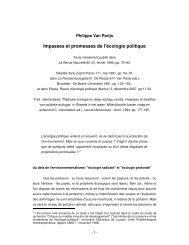Traitement automatique du signal ECG pour l'aide au diagnostic de ...
Traitement automatique du signal ECG pour l'aide au diagnostic de ...
Traitement automatique du signal ECG pour l'aide au diagnostic de ...
You also want an ePaper? Increase the reach of your titles
YUMPU automatically turns print PDFs into web optimized ePapers that Google loves.
TABLE DES MATIÈRES 3<br />
3.4 Discussion . . . . . . . . . . . . . . . . . . . . . . . . . . . . . . . 36<br />
4 Effet <strong>de</strong> la sélection <strong>de</strong> caractéristiques 37<br />
4.1 Métho<strong>de</strong> . . . . . . . . . . . . . . . . . . . . . . . . . . . . . . . . 37<br />
4.2 Méthodologie . . . . . . . . . . . . . . . . . . . . . . . . . . . . . 37<br />
4.3 Résultats . . . . . . . . . . . . . . . . . . . . . . . . . . . . . . . 39<br />
4.4 Discussion . . . . . . . . . . . . . . . . . . . . . . . . . . . . . . . 41<br />
5 Effet <strong>de</strong>s outliers 43<br />
5.1 Métho<strong>de</strong> . . . . . . . . . . . . . . . . . . . . . . . . . . . . . . . . 43<br />
5.1.1 Elimination d’outliers <strong>de</strong> la base <strong>de</strong> données (type 1) . . . 43<br />
5.1.2 Elimination d’outliers après un clustering (type 2) . . . . 43<br />
5.2 Méthodologie . . . . . . . . . . . . . . . . . . . . . . . . . . . . . 44<br />
5.3 Résultats . . . . . . . . . . . . . . . . . . . . . . . . . . . . . . . 45<br />
5.3.1 Elimination <strong>de</strong>s outliers <strong>de</strong> la base <strong>de</strong> données (type 1) . . 45<br />
5.3.2 Elimination <strong>de</strong>s outliers après un clustering (type 2) . . . 45<br />
5.3.3 Sous-échantillonnage simple et élimination <strong>de</strong>s outliers . . 46<br />
5.3.4 Sous-échantillonnage <strong>de</strong> type Clustering et élimination <strong>de</strong>s<br />
outliers (type 1) . . . . . . . . . . . . . . . . . . . . . . . 46<br />
5.3.5 Sous-échantillonnage <strong>de</strong> type Clustering et élimination <strong>de</strong>s<br />
outliers (type 2) . . . . . . . . . . . . . . . . . . . . . . . 46<br />
5.4 Discussion . . . . . . . . . . . . . . . . . . . . . . . . . . . . . . . 46<br />
6 Validation <strong>du</strong> modèle 55<br />
6.1 Méthodologie . . . . . . . . . . . . . . . . . . . . . . . . . . . . . 55<br />
6.2 Résultats . . . . . . . . . . . . . . . . . . . . . . . . . . . . . . . 58<br />
6.3 Discussion . . . . . . . . . . . . . . . . . . . . . . . . . . . . . . . 59<br />
7 Conclusions 61<br />
7.1 Résumé . . . . . . . . . . . . . . . . . . . . . . . . . . . . . . . . 61<br />
7.2 Discussion . . . . . . . . . . . . . . . . . . . . . . . . . . . . . . . 61<br />
7.3 Problèmes rencontrés . . . . . . . . . . . . . . . . . . . . . . . . . 62<br />
7.4 Trav<strong>au</strong>x futurs . . . . . . . . . . . . . . . . . . . . . . . . . . . . 63



